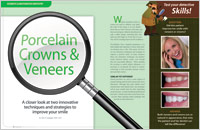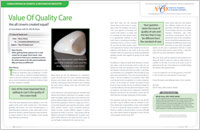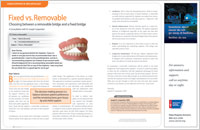Bluff Creek Dental Crowns and Bridges
Dentistry is an art as well as a science. A fine example of this is the dental crowns offered at Bluff Creek Dental. When crafted from today's high-tech porcelains (dental ceramics), crowns placed by your local Chanhassen, MN dentist offer many benefits in terms of practicality and aesthetics.
Crowns strengthen damaged teeth, allowing them to function normally again. And, as they are virtually indistinguishable from natural teeth, they enhance the look of your smile. They can even be designed to improve upon a tooth's original appearance.
What is a Crown?
A dental crown or “cap” is a covering that fits over a damaged, decayed or unattractive tooth. It can even replace a tooth entirely as part of dental bridgework.
Unlike veneers, which only cover the front surface of teeth and need natural tooth structure to support them, crowns completely cover teeth above the gum line. Therefore, if a tooth were missing a significant amount of structure above the gum line, a crown could be your ultimate restoration of choice.
Materials of a Dental Crown
There are other materials besides porcelain that your dentist can use to make dental crowns, depending on what qualities are most important to you. For example, for durability, cast gold can't be beat. However, this is not always the most aesthetic choice, especially if the affected tooth is toward the front of the mouth.
Another possibility is porcelain-fused-to-metal crowns (PFM crowns), which have a metal interior for strength and a porcelain exterior for a more natural appearance. Additionally, all-porcelain crowns with zirconia are considered the strongest type of ceramic available.
The Crowning Process
Crowning or capping a tooth will usually take two to three visits. During your initial visit to our Chanhassen, MN dentistry and cosmetic dentistry practice your tooth will be prepared to receive its new crown.
The first step in this process is to shape the tooth to fit inside the new covering. This will involve some drilling to give the tooth a uniform shape. The tooth and the surrounding area will be numbed beforehand. If there is very little tooth structure left to begin with, the tooth may have to be built up with filling material, rather than filed down, to support the crown.
After the tooth is prepared, impressions of your teeth are taken, either digitally or with reliable, putty-like impression materials, and sent to the dental laboratory. There, the impressions will be used to make models of your teeth for the creation of a crown. The models will serve as guides to the highly skilled Chanhassen lab technicians, who will ensure that your new crown is designed to enhance your smile and function well within your bite.
Before you leave our Chanhassen office, your dentist will attach a temporary crown to your tooth to protect it until the permanent crown is ready. At the second visit, your permanent crown will be attached to your tooth with either a resin that hardens when exposed to special light, or a type of permanent cement.
Creating a Bridge
Dental crowns can also be used to create a lifelike replacement for a missing tooth. This is done through bridgework, which spans the space of a missing tooth and requires at least three crowns.
The Three Crowns
Two of the crowns involved in the bridging process will be placed over healthy teeth on either side of the missing tooth. (These healthy teeth are referred to as abutment teeth.) The two crowned abutment teeth become supports for a third crown placed in between them. (That third crown is referred to as a pontic.) If more than one tooth is missing, more crowns will be needed to bridge the gap in between the abutment teeth.
Abutment Teeth
The number of abutment teeth necessary to replace missing teeth is influenced by several factors, including:
- Number of missing teeth
- Size and length of the abutment tooth roots
- Amount of bone support within each abutment tooth
- Where in the mouth the missing tooth is located
For example, if you have three missing teeth, four abutment teeth may be necessary, thereby creating a seven-tooth bridge. Engineering and designing of the bridge requires a keen understanding of how to replace teeth, as well as an in-depth knowledge of supporting gum and bone tissue biology, both of which Dr. Schold is skilled in.
Caring for Your Crowns & Bridgework
- Crowns and bridgework require the same conscientious care as your natural teeth. Be sure to brush and floss between all your teeth—restored and natural—every day to reduce the buildup of dental plaque.
- Avoid using your teeth as tools (to open packages, for example).
- If you have a grinding habit, wear a nightguard while you sleep to protect your teeth and your investment.
- When you have dental crowns it is more important than ever to maintain your regular schedule of cleanings at our Chanhassen, MN dentists’ office.
Your Crowning Glory
Dr. Schold would be happy to discuss the pros and cons of your various dental crown and dental bridge options with you. If you have questions about these, or other general or cosmetic dentistry services like dental implants or teeth whitening, feel free to call our Chanhassen office today. You can contact us through email, or reach out to us directly at (952) 679-6360. We would be happy to hear from you.
For more information on dental crowns or bridges in the Chanhassen, MN area call Bluff Creek Dental at 952-679-6360 today!
Related Articles

Porcelain Crowns & Veneers Dear Doctor magazine examines two innovative strategies for improving your smile. In many instances, these two restorative techniques can produce nearly identical aesthetic results, even though they are designed differently for handling different structural problems... Read Article

Value Of Quality Care Are all crowns created equal? And why are some crowns more expensive than others? Crown fabrication costs depend upon the materials used and the time needed to create them, among other factors. Dear Doctor magazine examines these variables... Read Article

Fixed vs. Removable Bridgework For those patients who have lost all their teeth, but have not lost significant bone, a fixed bridge (permanent non-removable teeth) may be the treatment of choice. For those who have severe bone loss, an implant-supported overdenture offers significant advantages... Read Article



